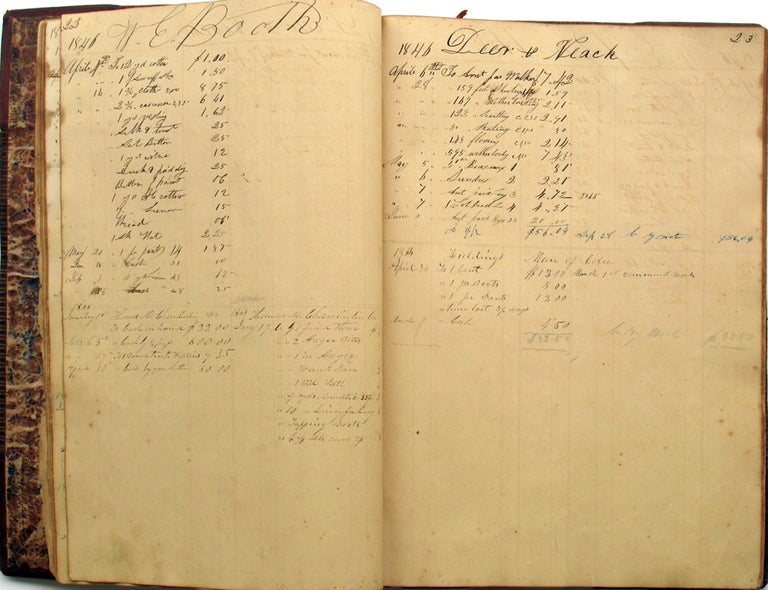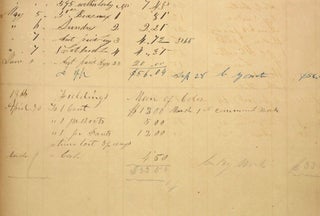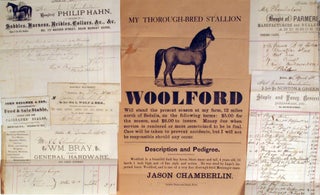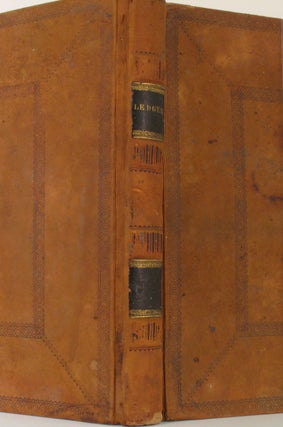Pre- & post Civil War era Manuscript Account Book of a Kentucky Hemp producer and a Missouri farmer, Jason Chamberlain/in.
Kentucky, Missouri: 1846 - 1880. Hardcover. A lengthy ledger providing unique insight on hemp and other agricultural production in Missouri, a key border slave state, and the use of black and emigrant labor in the period immediately following the Civil War. Two separate accounts in one volume, the first account of an unknown Kentucky hemp and dry goods merchant spanning the period 1846 to 1851, written in ink, at the top of the pages (&) the second account, (repurposing the empty areas) belonging to Jason Chamberlain [b. 1804 Vermont - d. 1901 Missouri?], writing in pencil on the lower portion of the same pages to record debits to his employees (farm & drygoods) and credits for their labor, from 1853 to 1880.
The first account owner, whose business Chamberlin may have taken over, sold textiles such as cotton, silk, calico, linen, and buttons; also candy, sundries, tea, coffee, tobacco and indigo as well as hemp and rope. His hemp and rope accounts are summarized on five pages which give the monthly total sales specifically for hemp and rope from 1847 through 1851.
Chamberlin initially sold mostly hemp and rope in the 1850's, adding meat, livestock and grains following the Civil War as his farm expanded. The cultivation of hemp was made possible before the War only through slave labor. Hemp was highly valued for the production of rope to bind cotton bales and moor flat boats; male slaves were prized for their strength in cutting the hemp cane. In the 1860 Federal Slave Schedule, Chamberlin is recorded as owning 12 slaves - 9 male and 3 female.
Here, Chamberlin carefully records black labor on his farm immediately following the close of the war. As early as March 1 1866 he records "Fieldings Man of Color" and "Jess Man of Color" both employed by him: "March 1st commenst (sic) work". Fieldings' and Jess' purchases of clothing and cash loans are also recorded. Jess was paid $15 per month. "Marshall, Robert and John Huston", three "Boys of Color" were employed in early 1866, and paid $8, $15 and $10 per month respectively. In 1867 two laborers with the surname Pitman, and not identified as black, are paid $26 per month. Their work schedules are carefully recorded, including "lost Time"; much of the work is "cutting poles", sowing seed, mending fences, and herding cattle.
Interestingly in 1868 Chamberlain also records emigrants he employs, identified only as "England" and Emigrant "Carlston" (p52 & 53). In the late 1860s he begins to purchase a significant amount of livestock (p71), which he continues right through the 1870s, recording his last entry on July 12 1880.
In the Civil War Missouri was a border and slave state which sent soldiers and supplies to both North and South; it had separate governments representing each side. The town of Sedalia, where Chamberlain's farm was located, had the good luck to be the terminus of the Pacific railroad which made it a strategic location and a federal military post during the War. The town was also the origination point for many of the trade routes to Texas and to Indian Territory, and so was an important center of trade, even after the arrival of the railroads. Even though the feeling in Missouri was that the slaves were somehow to blame for the War, Chamberlain nevertheless employed them as free men along with emigrants.
Approximately 130 people are listed in Kentucky from 1846 to 1851, including two men "of cullar (sic)", Henry Duncan & Abraham Saundes. Others include Robert Baird, James Truman, Joseph Beach, David Graham, Joseph Deer, Jason Burks, A. Sanders, Daniel Cook, Samuel Porter, Thomas Sheapheard, John Van Vleat, M. Willis, C. Sampson, William Montgomery, Charles Rice, John Gill, etc. [Harry Truman's ancestors migrated from Virginia to Kentucky to Missouri, but a relationship with James Truman was not immediately apparent.]
Approximately 160 people are listed in Missouri ledger from 1853 to 1880, including men and boys "of color" (some names listed above.) Other names include Thomas Chamberlin, Ed Pitman, William Taylor, Kelch & Field, Mike, Edmund Roberson, Honey Bop, etc.
Folio, full calf with black tooled compartments at front & rear boards. Manuscript page numbers through p130; followed by 66 unnumbered pages. Many receipts, loose notes and papers including 10 printed billheads (1866-1881) and approximately 40 manuscript receipts. Some notable receipts include an 1877 invoice from a saddle company, Philip Hahn; a trade card for Henock & Jacobs for men's and boy's clothing; trade card for John Kullmer & Son, feed and sale stable; a small broadside from Chas. Hobereht whose saddlery & harness business is moving locations; an impressive broadside with a woodblock of a "very find thorough-bred messenger MARE" named Woolford being offered for sale by Chamberlin.
Chamberlain was born in Vermont and migrated west, living in Kentucky and Missouri. In 1820, there is a Jason Chamberlain whose name is on a petition to Congress, dated 1817, from inhabitants of the counties of Cape Gerardeau, new Madrid, Lawrence and Arkansas seeking for the establishment of a mail route between these counties. In 1860, there is a Jason Chamberlain recorded in the 1860 Slave Schedule living at Heath's Creek, Pettis Missouri.
A revealing account of business & hiring practices in the Missouri Territory both pre and post the Civil War. Very good condition. Item #22002
Sold





